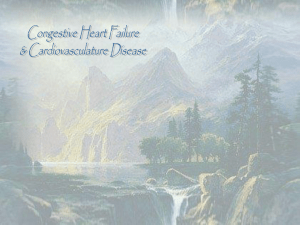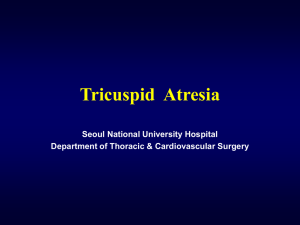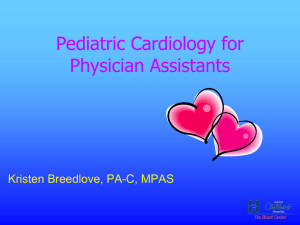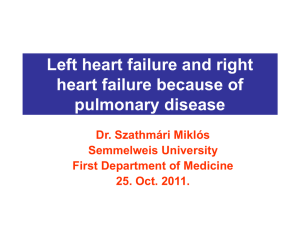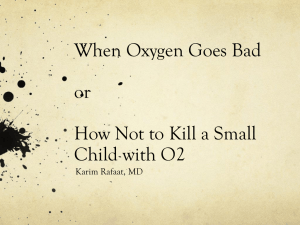Survival Patterns of Adults with Congenital Heart Disease
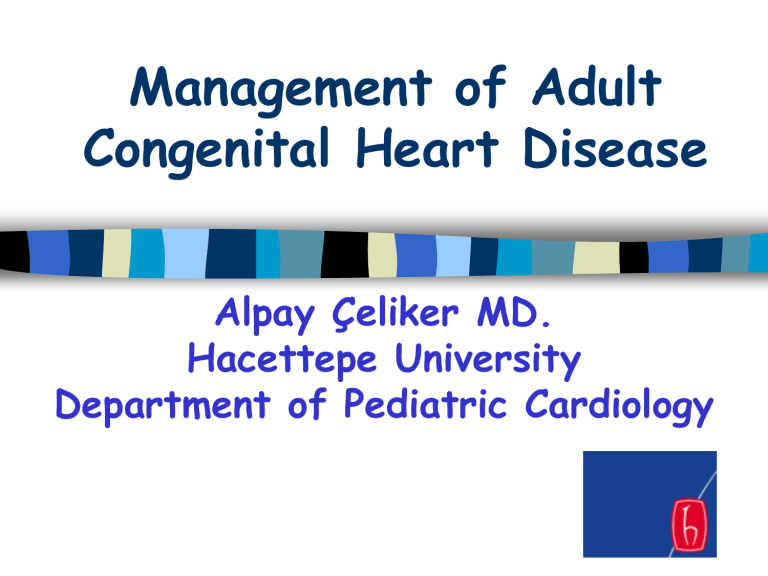
Management of Adult
Congenital Heart Disease
Alpay Çeliker MD.
Hacettepe University
Department of Pediatric Cardiology
Congenital Heart Defects in Newborn
8%
Cardiac Operation
60 %
Possibility to reach adulthood
85%
Major Issues in ACHD
Primary Operation or intervention
Reoperation or reintervention
Heart Failure
Arrhythmia
Sudden Death
CHD`s that do not Require
Operation
Functionally normal bicuspid aortic valve
Mild pulmonary valve stenosis
Small interatrial connection
Small VSD!!!
Uncomplcicated L-transposition
Types of Surgery for
Congenital Heart Disease
Curative : No postoperative residua, sequelae, or complications
Reparative : Anatomic repair or reconstruction with obligatory postoperative residua or sequelae
Palliative : Basic morphologic anomaly is neither repaired or reconstructed
Reoperative : Late reoperation after reparative or palliative surgery
Organ transplantation
Conditions with Specific
Interest
Aortic coarctation
Left-to-right shunts
Repaired tetralogy of Fallot
Atrial switch procedures
Fontan circulation
Coarctation of Aorta
Major Concerns :
– Residual hypertension, aneursym formation, recoarctation
Survival&Hypertension
– Hypertension
• Operation between 20-40 yrs may result
80% residual hypertension.
– Operation age
• 20-40 yrs 25 yr survival 75%
• >40 yrs 15 yr survival 50%
Surgery
Stent Implantation
Balloon Expandable Stents
Covered Stents
Neointima Formation
I. Method in Recoarc
Isolated Aortic Coarctation
Balloon Dilation
Dangerous!!!
Left-to-Right Shunt
Lesions
Major problem is pulmonary vascular disease
Unrestricted VSD`s rarely reach adult age without PAH
PDA and ASD can be successfully managed by transcatheter methods
Small VSD should be followed clinically, unless AVP and Aortic regurgitation
May result with Eisenmenger syndrome
ASD Closure
ASD II can be closed by interventional methods.
Two major problem may contribute
– Pulmonary vascular disease
– Decreased left ventricle compliance
– Balloon occlusion test should be performed
PDA Closure
Small PDA Endarteritis
Moderate size PDA Left ventricle and atrial dilation
Large PDA Pulmonary vascular disease
Transcatheter closure avoids from general anasthesia, thoracotomy
Large PDA’s can be closed surgically
Amplatzer Plug
Detechable Coil
Cardiac Surgery&Frequent
Complications in some CHD’s
Total correction for tetralogy of Fallot
– Atrial and ventricular arrhythmias
– Pulmonary regurgitation
Atrial switch procedures for D-TGA
– Atrial arrhythmias, Sick sinus syndrome
– Right ventricle failure
– Baffle obstruction
Fontan circulation
– Atrial arrhythmias, sick sinus syndrome
– Protein losing enteroptahy
– Conduit obstruction
Late Complications after Tetralogy
Repair
Endocarditis
Aortic Regurgitation
LV Dysfunction
Residual RVOT Obstruction
Residual Pulmonary regurgitation
RV Dysfunction
Exercise Intolerance
Heart Block
Atrial Fl and Fib
Sustained Ventricular
Tachycardia
Sudden Cardiac Death
Total Correction and
Arrhythmias
Ventricular arrhythmias
– Late operation\Long follow-up duration
– Residual VSD
– Severe Pulmonary regurgitation
Atrial arrhythmias
Sinus node and AV conduction disorders
Risk Assessment
ECHO
– Residual VSD, PS
– Degree of Pulmonary& Tricuspid Regurgitation
– Right ventricle status
ECG
– Prolonged QRS duration
– Abnormal late potentials
Holter
– Ventricular ectopy, NSMVT or SMVT
Exercise
– Increased ectopy, VT
Invasive EPS
MRI
ECHO
It is helpful in determining left ventricle function, residual VSD and residual PS
There is no concensus determining Pulmonary regurgitation with
ECHO
Right ventricle ejection fraction can not be measured
ECG and Holter
Positive late potentials and wide QRS
(>180 msec) is well-known risc factors associated with ventricular tacyhcardia
Ventricular ectopic beats and nonsustained monomorphic VT are other factors related with SMVT
MRI
Right ventricle size
Right ventricle ejection fraction
MRI II
Degree of
Pulmonary regurgitation
Determining fibrotic and aneursymatic areas
Time consuming
Severe PR
Trace PR
Cardiac EPS in Fallot Patients
Common AV conduction disturbance
Common atrial flutter
Infrequent inducible SMVT
Ablation in tolerated VT’s
ICD in fast VT or cardiac arrest
Hacettepe Experience: EPS in Fallot
Patients
*
Result Patient No %
NORMAL
SSS
AVCD
SSS+AVCD
NS AFL
SSS+AFL
S AFL
Fibro-flutter
SSS+NSVT
NSVT
TOTAL
2
1
2
1
2
3
30
3
3
12
1
6.7
3.3
6.7
3.3
40
3.3
10
10
6.7
10
100
*: 30 patients after 11 years tetralogy repair
Reoperation in Tetralogy
Residual VSD with a QP/QS>1.5
Residual PS with RV/LV>2/3
RVOT aneursyms
Branch PS & Pulmonary regurgitation
Severe pulmonary regurgitation with;
– Right ventricle enlargement
– New onset tricuspid regurgitation
– Ventricular tachycardia
– Deteriorating exercise intolerance
Significant aortic regurgitation
Mustard & Senning Procedures
Right ventricle dysfunction
– ACE inhibitors, digitalis, diuretics
Atrial flutter
– AA treatment, catheter ablation, antitachycardia pacemaker
Sick sinus syndrome
– Brady pacing
Baffle obstruction
– Surgery or intervention
Fontan Circulation
Arrhythmia: 41 % sustained IART and many of them SSS findings
Protein Losing Enteropathy (PLE)
Ventricular Dysfunction
Thromboembolism
Conduit obstruction
Pulmonary artery stenosis
Pulmonary arterivenous fistulae
Plastic bronchitis
Stent implantation in LPA stenosis in Fontan
Fontan & Arrhythmia
SSS or AV Block
– Epicardial pacing
– Pacing from coronary sinus
IART or atrial flutter
– DC cardioversion
– AA drug therapy
– Catheter ablation with
3D mapping
– Arrhythmia surgery
Coronary sinus angio
Coronary sinus lead in place
PLE
– Diuretics
– Supplemental albumin infusion
– High protein and medium-chain triglyceride intake
– Oral steroids, heparin
– Atrial fenestration
Thromboembolism:
– Anticoagulation and antiplatelet therapy
Heart Failure
– Conversion to Cavopulmonary anastomosis
Heart Failure in ACHD
Chronic Treatment
– ACE inhibitors
– Diuretics
– -Blockers
– Aldosterone antagonism
– Digitalis
Acute Treatment
– Dopamine, dobutamine
– Milrinone
Biventricular pacing
Sudden Cardiac Death
Adults with CHD
Sudden Death
Surgically repaired Tetralogy of
Fallot
Atrial switch operation D-
Transposition
Aortic stenosis
Coarctation of aorta

